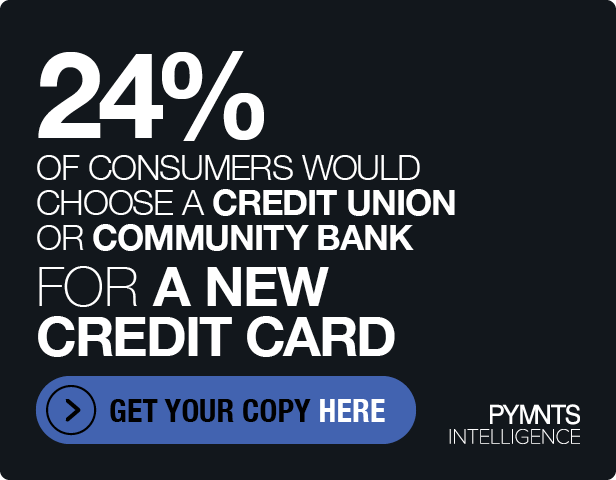PSCU CEO: The Quiet Power Of Credit Unions’ 100M-Member Network

Credit unions can be easy to overlook and underestimate — individually, they generally don’t have a massive amount of assets, their membership bases are often pretty small and more localized, and on average their rate of credit card penetration among members is pretty small: 15 to 17 percent on average.
But, as PSCU President and CEO Chuck Fagan told Karen Webster in a recent conversation, looks can often be deceiving when it comes to credit unions, because while they may be small alone, in aggregate they pack quite a punch. As of today, there are over 5,000 credit unions in the U.S., collectively representing 100 million members and holding over a trillion dollars in assets.
Moreover, while big banks tend to generate customer complaints more easily than they generate customer praise and enthusiasm, credit union members seem to genuinely like banking with them. According to a recent iteration of the PYMNTS Credit Union Tracker, 81 percent of credit union members report being highly satisfied with their services. Satisfaction stems from the fact that credit unions have a reputation for being less expensive, less complicated to deal with and delivering a “higher touch” level of service than their larger bank counterparts.
The challenge, Fagan noted, is keeping up that high level of consumer satisfaction in the digital age, as consumers now expect a certain level of service when it comes to mobile banking, payments, and loyalty or security. The expectations are high, he said, and the margins for error are slim. Individually, most credit unions simply aren’t equipped to take on the challenge of building out modern digital infrastructures to support those offerings.
PSCU works with credit unions individually, and as a collective network, with an emphasis on bringing forward “leading-edge technologies,” solutions and programs that optimize credit union operations. Today, Fagan noted, they support over 900 credit unions and their collective 43 million members, with a focus on not just building for those members, but building solutions with them.
The Member Experience
What consumers like about using credit unions, as opposed to big banks, is that the service seems more personalized to meet their needs. Servicing credit unions, Fagan told Webster, means that PSCU needs to take that relationship and that set of needs as seriously as the credit union itself does, because that relationship is quite literally everything.
The trick, he said, is staying on top of — and even ahead of — members’ upcoming needs, not just today’s needs. By way of example, he noted that in the ’90s, “gold cards” became a favored way of signaling a credit offering’s premium nature, and credit unions wanted to offer them. The difficulty at the time was that to offer a gold card, financial institutions had to offer 24/7 customer support to go with it — something that individual credit unions didn’t really have the capacity to do. PSCU offered a solution for the aggregate, so that via a call center servicing a myriad of credit unions, they could offer the right support for gold cards.
However, Fagan noted, by the early aughts, the world had already changed a bit.
“As members were able to access their card information online, we saw a dip in call volume,” he said. “But because the investment made by the credit union owners of PSCU in the call centers was already there, the question is — how can we use them? So, we expanded out from the base as a card service call center to a call-in hub for full-service calls across accounts.”
To support that, PSCU deployed technology so they could “provide a full-spectrum, full-service solution that could access a member’s checking, savings and loan products, as well as their cards.”
As PSCU works to build for credit unions’ needs going forward, their advantage is their proximity to the industry — they are owned by credit unions, and every member of the board is a CEO of one. Moreover, Fagan noted, as a regular feature of their product development efforts, PSCU makes it a point to be consistently in the branches of the credit unions they service.
“When we are developing and rolling out new products, we are sitting in the branch department, because we need to get a clear picture of a day in the life of people who use our systems,” Fagan said.
That allows them access to where the pain points are, where the demand is and where the needs are. They also critically point the way to places where education and training are needed for workers, so that the shiny tools they build go into the hands of people who understand them and are prepared to use them.
Training, Fagan noted, is often an area that sits on the funding chopping block, because the payout from the investment isn’t always as obvious.
“But the tools don’t matter — not to the credit unions or to their members — if no one can use them, or staff doesn’t know how to promote them,” he stated. “For every technological upgrade, there is a very human element that can get overlooked, even though it is critical. It can’t just be working in theory; it has to work in our 900 credit unions.”
The Power of the Network
With nearly a thousand credit unions representing over 40 million members, PSCU has something that one generally wouldn’t associate with the smaller institutions they work with: data. Troves of it — knowledge generated across the network and the 2.3 billion transactions that PSCU sees each year, and the 4.5 billion they are expecting their annual transaction rate to reach within the next two years as a result of their new partnership with core banking provider Jack Henry.
And that data, Fagan noted, is extremely useful in a variety of contexts — like fraud mitigation. Their systems can spot fraud in a single instance, such as a user trying to break into the system with stolen credentials. The fraud detection system obviously needs to first stop the attempted break-in at that single touchpoint. But PSCU fraud detection is also designed to think bigger — once fraud is found at one touchpoint, the artificial intelligence (AI) is now turned loose across that network to see where similar fraud is being attempted and why. Fraud, Fagan noted, is complicated — one might be looking at an account takeover, or at a fraudster attempting to access a reward system and do some points looting.
The options for fraudsters are always expanding, he noted, as securing a network means using the right analytics tools to see the whole picture — not just every attempted break-in as a one-off event.
“And when we look at the data and information, we really understand our partners a lot better across channels,” Fagan said. “We want to be able to position credit unions with the right products across all channels, so they can build those cutting-edge user experiences and really best position the credit union for continued growth.”
What’s Next
When it comes to what’s next, Fagan noted, PSCU is doing what they usually do: going back to the drawing board to figure out how to build out and roll out the next round of tools and enhancements for credit unions.
Security and fraud, he noted, is a particular area of concern, because the arms race in that area is ongoing.
“If you don’t think the cybercriminals aren’t also using AI, that is a huge error. This is always going to be a game about staying maybe a step ahead.”
More broadly, he noted, they are working with their credit unions to embrace coming and emerging technology, particularly when it comes to payments. That is partly an education effort, Fagan noted, and partly an effort in bolstering confidence among members. The goal, he stated, is to train credit union workers so well in payments that they are able to go to a member and talk about contactless and other advances that communicate it is going to be a factor in their lives, and that this is good news, not bad news.
The real key, Fagan said, is collaborating with credit unions and focusing the technological offerings around what they need, based on their own reporting.
“I am a big believer in a sign I saw on someone’s desk: If you build it, they might come, but if you build it with them, they are already there,” he said, noting that getting everyone “already there” and on the same page is critical. But it’s also only a first step — and the next one, figuring out where to go next, isn’t easy.
